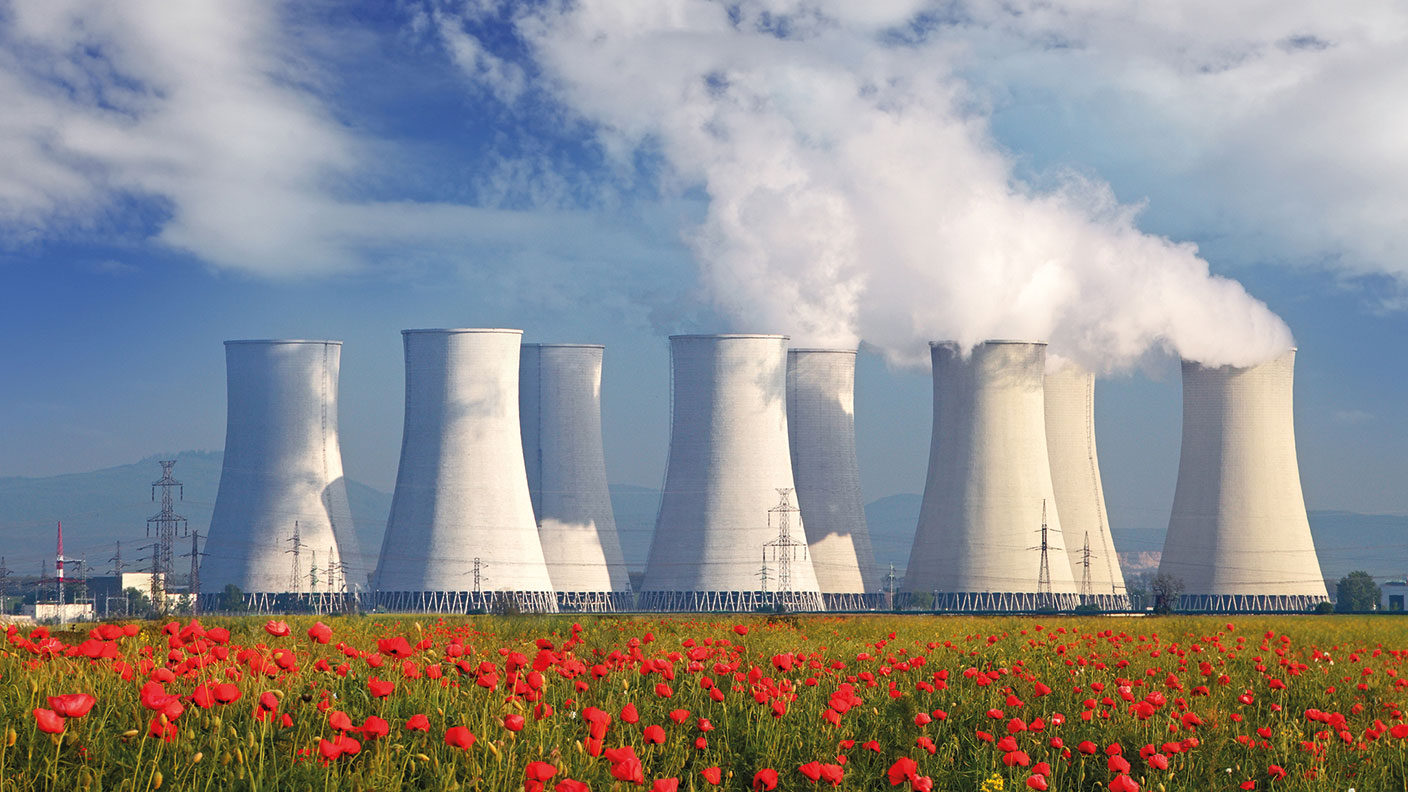The nobbling of Britain’s nuclear energy sector
The UK once led the world in nuclear energy, but now it’s a has-been. The malaise is due to the left’s opposition and decisions taken by the Blair government.

You don’t have to be a faithful follower of the net-zero advocates to believe that reducing the UK’s dependence on imported hydrocarbons and encouraging others to do likewise is an economic imperative.
There is a mountain of evidence that the possession of hydrocarbon wealth is responsible for corruption, aggression, repression, and economic mismanagement – it undermines enterprise in countries that are “blessed” with it. These include Russia, Iran, Venezuela, Saudi Arabia and Nigeria, for whom it has financed extravagance for the few while helping to create misery for the many. The other losers are the hard-working and entrepreneurial people of countries that have to overpay for their energy.
Renewable energy has made an important contribution to reducing the UK’s dependence on hydrocarbons. But it can never be more than a partial solution. Despite falling costs and improving technology, output is limited by the unreliability of the weather and the challenge of low-cost storage. Expensive backup generation is needed, as well as a reliable base-load supply.
MoneyWeek
Subscribe to MoneyWeek today and get your first six magazine issues absolutely FREE

Sign up to Money Morning
Don't miss the latest investment and personal finances news, market analysis, plus money-saving tips with our free twice-daily newsletter
Don't miss the latest investment and personal finances news, market analysis, plus money-saving tips with our free twice-daily newsletter
Since the opening of the first nuclear power station at Calder Hall in 1956, that has been provided by nuclear energy. At its peak, nuclear provided roughly 30% of Britain’s electricity, but now the figure is less than 15%. That fall is the result of the closure of the original Magnox-type reactors and the failure to replace them with sufficient new capacity.
That failure is widely blamed on the Coalition government ducking the issue 12 years ago. But by then the damage to Britain’s capacity to build new nuclear power stations had been done. Besides, the Coalition government did much to accelerate the growth of renewable energy.
“British Nuclear Fuels Limited was a world leader in reprocessing spent fuel”
Why the Blair government caused the UK's nuclear failure
The real culprit for the nuclear failure was the Blair government that took office in 1997. The Major government had privatised British Energy, comprising the eight most modern of Britain’s nuclear power stations and various other nuclear assets, the previous year. British Energy acquired a coal-fired power station with a capacity of 2,000 megawatts in 2000 and a majority stake in a large Canadian nuclear power generator in 2001, both to diversify its exposure to the risks of UK nuclear.
By then, British Energy’s enemies in government were conspiring against it, led by Michael Meacher, a left-wing ideologue and the Minister of State for the Environment. He was egged on by Zac Goldsmith, then a leading environmental activist but later a Conservative MP, minister and now a peer.
The left’s opposition to nuclear power was based on its role in undermining the historic near-monopoly of coal in energy generation to the detriment of the coal miners, the Praetorian Guard of the Labour left. Without nuclear, they thought, the miners’ strike of 1984-85 would have succeeded. Nuclear energy also suffered from its name association with nuclear weapons, and CND (the Campaign for Nuclear Disarmament) was a leading left-wing cause. Environmentalists are and always have been divided on the issue of nuclear power, torn between solidarity with like-minded people overseas and rational analysis.
British Energy ran into financial difficulties in 2002 owing to a slump in the wholesale price of electricity, itself the result of the “dash for gas” in electricity generation caused by a glut of natural gas. This was exacerbated by the discriminatory levying of business rates, a result of the state’s refusal to exempt British Energy from the “Climate Change Levy” (despite nuclear energy being low-carbon). It required British Energy to provide for and set aside money for “back-end fuel costs” (reprocessing and disposal) and decommissioning. There was no comparable decommissioning levy on conventional power stations.
Historically, “back-end fuel costs” hadn’t been a problem, because spent fuel was reprocessed and re-enriched by BNFL (British Nuclear Fuels Limited) at Sellafield. Around 96% of nuclear fuel can be recycled through reprocessing.
BNFL had been set up in 1971 as a business operating independently from the government but owned by it. Turnover in the mid-1990s was £1.5bn-£2bn a year, up to half from overseas, and BNFL was very profitable, paying a dividend to the Treasury in 1996 of £60m. Japan was a major customer (BNFL accounted for 10% of all the UK’s yen earnings) but Germany, Sweden, Switzerland and Belgium were also significant.
“BNFL was a world leader in the management and reprocessing of spent fuel,” says Neville Chamberlain, former CEO. “Had it been allowed to continue, turnover would be a multiple of what we achieved in the 1990s. Closing it was a massive lost opportunity for a world-leading business with excellent prospects, and did untold damage to Britain’s reputation overseas.”
The first step towards closure was actually taken in 1993 by Michael Heseltine, then president of the Board of Trade when he brought it under Treasury control. As Lord King, chairman of British Airways in the 1980s, said, “government is totally unsuited to being the proprietor of a commercial enterprise”. So it proved with BNFL, with “the department behaving in an anti-nuclear way”, according to Chamberlain.
The Blair government decided that reprocessing the spent fuel for the older Magnox power stations would continue but there would be no reprocessing for the more modern plants, with the spent fuel being very expensively stored instead. This significantly increased British Energy’s costs. British Energy also asked for the life of the Magnox power stations to be extended as the best way to manage and pay for decommissioning. This was only allowed after the government had seized control of British Energy.
In 2002, British Energy approached the government for financial assistance to cover what it believed was only a short-term drop in revenues. The government insisted that British Energy, which had no choice but to generate electricity flat out because nuclear power plants can’t be turned on and off at the flick of a switch, should be subject to fluctuating short-term prices, not contractual long-term ones. This policy was not applied to renewable energy.
The government came up with a restructuring plan to enable it to seize control. It was supported by British Energy’s directors, led by a government-installed chairman, Sir Adrian Montague, who insisted that the company faced insolvency if, as a result of shareholders voting against it, the restructuring failed to proceed.
But then disaster struck. In late 2002, electricity prices started to recover, nearly doubling by 2004. Deutsche Bank forecast that the company could be almost debt-free by the end of 2004 and generate £580m of profits and £780m of cash flow in the year to 31 March 2006.
Under the restructuring, this would mean paying £500m (65% of cash flow) to the Nuclear Liabilities Fund, responsible for decommissioning. This was about ten times the amount that Sweden’s nuclear power stations were asked to pay under a carefully assessed plan.
Meacher had been fired by Blair, a prime minister who was starting to have second thoughts about dismantling Britain’s nuclear power industry, but Montague was not to be deterred, threatening to get the shares delisted if shareholders dared to vote against the restructuring of a now highly solvent company. In the end, the restructuring was bulldozed through without a shareholders’ vote with the help of creditors and bondholders, for whom it was highly lucrative.
Under government control, British Energy quickly sold off its coal-fired power station, Canadian investment and other valuable assets at knock-down prices (about 18 months’ earnings for the Canadian business). Even so, France’s EDF was prepared to pay £12.5bn for the core nuclear power stations in 2008.
It wasn’t just British Energy’s shareholders who lost out. Nuclear power stations were now scheduled to be closed down gradually rather than swiftly, but there was no chance of new construction. As the industry shrank, expertise and skills were lost. The cost of new power stations such as Hinkley Point and Sizewell C is now considerably higher than it should be. Britain once led the world in nuclear power, but now it’s a has-been.
“A Starmer government will be even more financially constrained than Tony Blair’s”
How to rebuild the UK's nuclear sector
A private sector that has learned to be distrustful of government demands a higher and more certain return on investment, guaranteed by high contractual electricity prices, to get involved. Only a few overseas firms – EDF and the Chinese – are interested and it has been a painfully slow process to get started. Meanwhile, the UK must rely on expensive imported hydrocarbons.
There are other key lessons for the future. The Blair government was committed to sound finance rather than the tax-and-spend that Labour had previously been associated with. They had to satisfy their socialist cravings in other ways: by banning fox hunting, not replacing the royal yacht Britannia and closing down nuclear power. The third, like the first two, seemed to be a low-cost measure at the time but has turned out to be extremely expensive.
A Starmer-led government will be even more financially constrained than Blair, probably forced by bond markets to impose unpopular austerity. What will it do to satisfy its inner socialist? As for nuclear energy, “there is a major role for it if it can be built on time and if it is less costly than Hinkley”, says Professor Tony Roulstone of Cambridge University. He points out that half of Hinkley’s budget was spent before the first sod of earth was cut. “This requires standard, modular reactors built by the private sector.”
“We can’t take a constant supply of energy for granted,” says Chamberlain. “The conundrum of affordable energy and carbon commitments can only be solved with nuclear. We need energy that is safe, affordable, reliable and clean. There is no need to throttle our economy or worry about the weather or the turbulence of global events. Only nuclear ticks all the boxes.”
This article was first published in MoneyWeek's magazine and all information was correct at the time of writing. Enjoy exclusive early access to news, opinion and analysis from our team of financial experts with a MoneyWeek subscription.
Related articles
- Is the market missing the opportunity in energy?
- The demand for oil is slowing and green energy is taking over
- Why now looks like a good time to invest in nuclear power
Get the latest financial news, insights and expert analysis from our award-winning MoneyWeek team, to help you understand what really matters when it comes to your finances.

Max has an Economics degree from the University of Cambridge and is a chartered accountant. He worked at Investec Asset Management for 12 years, managing multi-asset funds investing in internally and externally managed funds, including investment trusts. This included a fund of investment trusts which grew to £120m+. Max has managed ten investment trusts (winning many awards) and sat on the boards of three trusts – two directorships are still active.
After 39 years in financial services, including 30 as a professional fund manager, Max took semi-retirement in 2017. Max has been a MoneyWeek columnist since 2016 writing about investment funds and more generally on markets online, plus occasional opinion pieces. He also writes for the Investment Trust Handbook each year and has contributed to The Daily Telegraph and other publications. See here for details of current investments held by Max.
-
 Football fans issued warning over ticket scams ahead of 2026 World Cup
Football fans issued warning over ticket scams ahead of 2026 World CupSantander customers lost more to football scams in the first six months of 2025 compared to the same period in 2024, when total losses surged due to the Euros
-
 Nationwide fined £44 million over “inadequate” anti-money laundering systems
Nationwide fined £44 million over “inadequate” anti-money laundering systemsFailings in Nationwide’s financial crime processes between October 2016 to July 2021 meant one criminal was able to deposit £26 million from fraudulent Covid furlough payments in just eight days.
-
 Who is Christopher Harborne, crypto billionaire and Reform UK’s new mega-donor?
Who is Christopher Harborne, crypto billionaire and Reform UK’s new mega-donor?Christopher Harborne came into the spotlight when it emerged he had given £9 million to Nigel Farage's Reform UK. How did he make his millions?
-
 The best Christmas gifts for your loved ones
The best Christmas gifts for your loved onesWe round up the best Christmas gifts with a touch of luxury to delight, surprise and amaze family and friends this festive season
-
 Leading European companies offer long-term growth prospects
Leading European companies offer long-term growth prospectsOpinion Alexander Darwall, lead portfolio manager, European Opportunities Trust, picks three European companies where he'd put his money
-
 How to harness the power of dividends
How to harness the power of dividendsDividends went out of style in the pandemic. It’s great to see them back, says Rupert Hargreaves
-
 Why Trustpilot is a stock to watch for exposure to the e-commerce market
Why Trustpilot is a stock to watch for exposure to the e-commerce marketTrustpilot has built a defensible position in one of the most critical areas of the internet: the infrastructure of trust, says Jamie Ward
-
 Tetragon Financial: An exotic investment trust producing stellar returns
Tetragon Financial: An exotic investment trust producing stellar returnsTetragon Financial has performed very well, but it won't appeal to most investors – there are clear reasons for the huge discount, says Rupert Hargreaves
-
 How to capitalise on the pessimism around Britain's stock market
How to capitalise on the pessimism around Britain's stock marketOpinion There was little in the Budget to prop up Britain's stock market, but opportunities are hiding in plain sight. Investors should take advantage while they can
-
 London claims victory in the Brexit wars
London claims victory in the Brexit warsOpinion JPMorgan Chase's decision to build a new headquarters in London is a huge vote of confidence and a sign that the City will remain Europe's key financial hub
